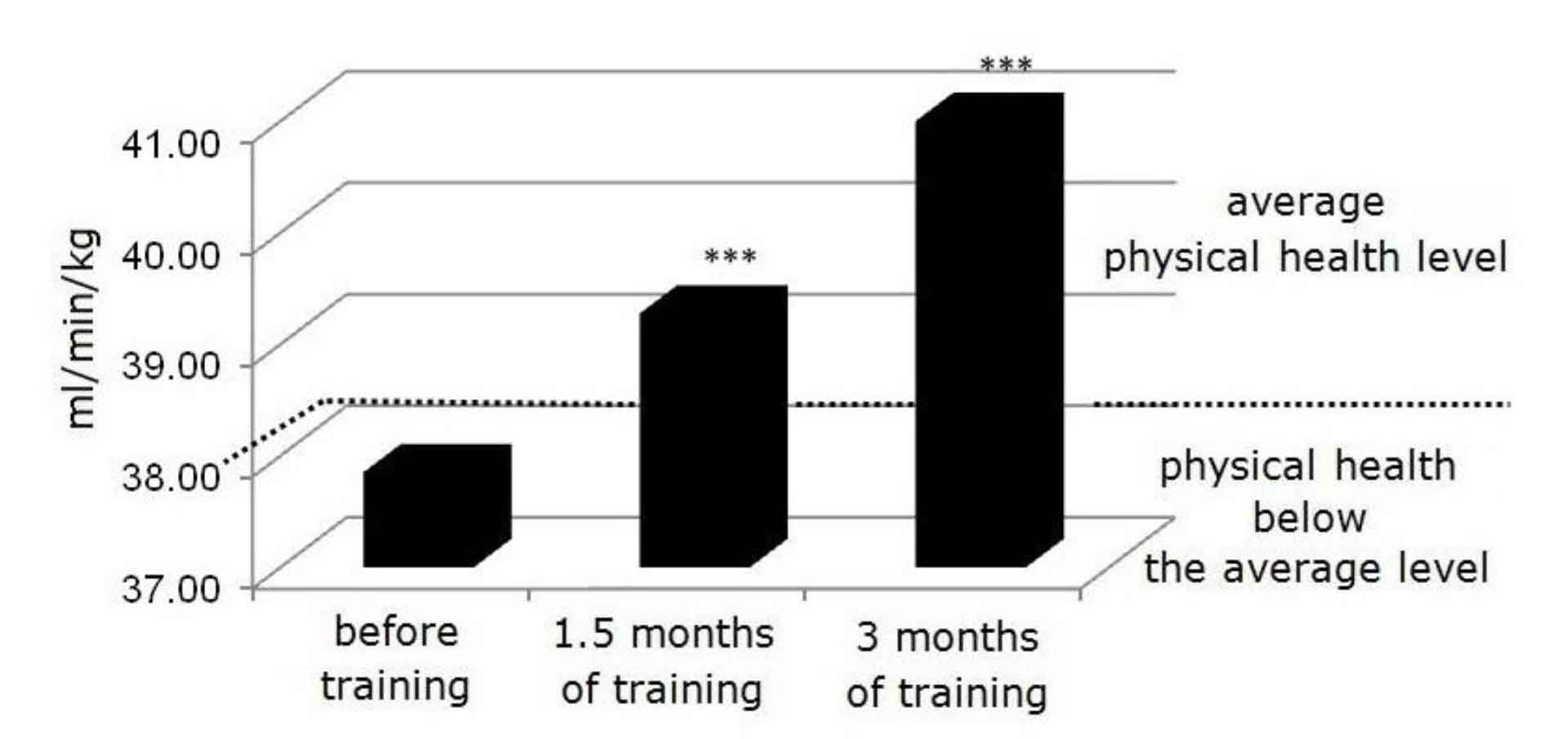Fitness training as preventive health care for railroad workers
Фотографии:
ˑ:
Professor, Dr.Hab. V.S. Makeeva1
Associate Professor, Dr.Biol. V.N. Pushkina1
Associate Professor, PhD I.E. Ivashkova1
Associate Professor, PhD A.N. Zelyanina2
1Russian State Social University, Moscow
2Northern (Arctic) Federal University n.a. M.V. Lomonosov, Arkhangelsk
Keywords: railroad workers, fitness training, physical working capacity.
Introduction. Most of the working-age population in Russia is employed in the railroad transportation industry. Over recent years a tendency towards numerous layoffs has been observed following medical disqualifications resulted from harmful and hazardous labor conditions: increased level of emotional stress, noise, electromagnetic radiation, presumable dire consequences of train accidents [3]. Furthermore, the work-rest regimen of many railroad engineers and their assistants is characterized by irregular day and night shift sequence, non-fixed working hour system, forced resting time at terminal stations (lasting for 4-6 hours and more), overtime work, irregular dietary regimen [4]. The third most common occupational disease of railroad workers is diminished hearing caused by the impact of intense occupational noise. The risk of hearing loss increases considerably after ten years of workplace noise exposure [5]. In addition to occupational noise, the long-term exposure to whole-body vibration poses serious health risks to railroad engineers and their assistants working in a constantly vibrating machine on a regular basis. The integrated effect of occupational noise and vibration results in reduced concentration, delayed response, loss in visual sensitivity and light perception [2]. Healthcare system is an important factor to the locomotive crew workers due to strict competence requirements; at the same time, it is a preventative set of activities, rather than the treatment of existing diseases, that should be taken under due consideration.
Objective of the study was to evaluate the effect of fitness training on the functional state of railroad workers.
Methods and structure of the study. The men employed as locomotive engineers and assistant locomotive engineers aged 26.16±1.14 took part in the study. Annual reports on prevalence rate, including cases that affect the functional status of railroad workers, were analyzed as part of the study. The cardiorespiratory system was assessed using timed inspiratory and expiratory capacity tests; PWC170 test (in modification of L.I. Abrosimova et al) for physical working capacity assessment; estimating maximal oxygen consumption calculated by the formula VO2 max = (1.7 × PWC170 + 1240) / body mass (kg); strength endurance of the spinal (exercise-based test “Superman”, sec) and abdominal muscles (time in the initial sitting position with the knees bent and the trunk at an angle of 60 degrees to the floor) was tested [1]. The fitness training program comprised exercises based on the Pilates fitness system once a week; combined circuit and interval training systems with short rest intervals twice a week; additional types of physical activities (regular morning hygienic gymnastics; elective individual workout: jogging, freestyle swimming, bicycling). Besides, the research subjects have been taking a psychoemotional status correction course (abdominal breathing, quick relaxation technique, autogenic training, progressive relaxation and relaxation reflex) using a Vibrosound chair; received hand-out materials on the subject “Healthy lifestyle skills”. Statistical data processing was carried out by the SPSS 13.0 statistical software package. Statistically significant differences equaled р<0.05.
Results and discussion. The analyzed annual reports on the prevalence rate among the railroad workers with functional status loss revealed the common weak points typical of the given group of people: respiratory system – 271 cases (60.8 percent), of which 213 cases constituted ARVI (47.8 percent), 34 cases – influenza (7.6 percent), 17 cases – acute bronchitis and acute exacerbation of chronic bronchitis (3.8 percent), 4 cases – pneumonia (0.9 percent), 3 cases – exacerbation of COPD (0.7 percent); musculoskeletal system – 47 cases (10.5 percent), of which 37 (8.3 percent) were the cases of osteochondrosis (such types as cervicobrachialgia, intercostal neuralgia, lumbago and lumbar ischialgia), 6 cases – osteoarthritis (1.3 percent), 3 cases – bursitis and synovitis (0.7 percent), 1 case – frozen shoulder (0.2 percent); ENT conditions – 46 cases (10.3 percent), of which 21 cases constituted tonsillitis (4.7 percent), 12 cases – acute sinusitis (2.7 percent), 7 cases – acute otitis media (1.6 percent), 6 cases – acute laryngitis (1.3 percent); 36 cases – digestive system disorders (8.1 percent), 24 cases of which constituted acute gastritis and exacerbation of chronic gastritis (5.4 percent), 6 cases – acute gastroduodenitis (1.3 percent), 3 cases – chronic cholecystitis and its exacerbation (0.7 percent), 2 cases – gastric ulcer and its exacerbation (0.4 percent), 1 case – acute appendicitis (0.2 percent). The obtained data proves the expert opinion on the fact that the railroad workers are exposed to risk of external respiration system disorders, which is a result of suboptimal microclimate at the workplace and thermal discontinuity. Gastrointestinal diseases are primarily caused by irregular eating regimen, poor nutrition, lack of food storage facilities on the train so that it reduces the food storage life and results in its spoilage. The musculoskeletal system of railroad workers is put at risk as a consequence of specific conditions during their professional activities, for instance, exposure to constant whole-body vibration, static magnetic fields and limited physical activity [2]. The study results showed improved indicators in all considered parameters after the fitness activities carried out among the railroad workers. Thus, at the time of the first experiment, a considerable low endurance in spinal and abdominal muscles was observed. The practical average value of the spinal muscles strength endurance was 46.25±1.20 sec, which means “poor” result. The analogues indicator denoting the abdominal muscles strength endurance equaled 35.25±0.85 sec or “satisfactory” result. Significant improvement has been observed in these indicators after the fitness training program: strength endurance in the spinal muscles increased by 19 percent, in the abdominal muscles – by 21 percent (р<0.001). At the beginning of the experiment, the practical average value of the timed inspiratory and expiratory capacity tests constituted 43.58±0.70 sec and 22.92±0.90 sec respectively; according to the evaluative scale, it means “satisfactory” result. At the end of the training program, the timed inspiratory capacity increased by 12 percent and timed expiratory capacity - by 18 percent (р<0.001). The initial indicator of the PWC170 test equaled 11.71 ± 0.12 kg-m/min/kg, which indicated the low level of physical working capacity and low potential of the cardiovascular system. As a result of fitness training, the PWC170 indicator increased by 14 percent (р<0.001); physical loads, determining HR increase to the appropriate level, was more intense as well and increased by 790.2±13.12 kg/m/min (climbing 29 sets of stairs per minute).
The improvement of maximal oxygen consumption indicator was observed along with the improved physical working capacity dynamics: VO2 max increased from 37.85±0.38 to 41.08±0.59 ml/min/kg (р<0,001); qualitative changes took place in the physical heath level resulting in its significant increase (Fig. 1).

Fig. 1. Dynamics of physical health level in terms of VO2 max indices of railroad workers throughout fitness training program
Conclusions. The analysis of the prevalence rate among the locomotive crew workers has revealed the common weak points that are typical of the given group of people; the organs of the respiratory, musculoskeletal and digestive systems are exposed to risk of diseases. As a result of fitness training, increased indicators were observed in timed inspiratory and expiratory capacity indices, strength endurance of the spinal and abdominal muscles, which indicates an improvement of the functional capacity of the cardiorespiratory system and the strength potential of the musculoskeletal system. Likewise, the increased levels of physical working capacity and maximal oxygen consumption are indicative of improved physical health of the railroad workers. Therefore, the development of more effective preventative services in the health care system for the railroad workers by the means of physical education will contribute to the decrease of the prevalence rate among this group of people.
References
- Epifanov V.A. Vypryami spinku: Sovety semi akademikov Epifanovykh (Stand up straight: Tips of seven academicians of Epifanov family) / V.A. Epifanov, A.V. Epifanov. – Moscow: EKSMO, 2011. – 160 p.
- Zheleznodorozhnaya meditsina (Railway medicine) / Ed. by N.I. Yablochinskiy, M.M. Mikhaylov. – Kharkov: Aktava, 2006. – 68 p.
- Kraevoy S.A. Sovershenstvovanie sistemy meropriyatiy po snizheniyu meditsinskikh poter' na zheleznodorozhnom transporte na sovremennom etape: avtoref. dis. …dokt.med.nauk (Improving modern measures to reduce railway health losses: Abstract of doctoral thesis (Med.) / S.A. Kraevoy. – Moscow, 2012. – 47 p.
- Sergeev V.I. Okhrana zdoroviya lokomotivnykh brigad i bezopasnost dvizheniya poezdov (Health care of train foot-plate staff) [Electronic resource] / V.I. Sergeev // Journal «Lokomotiv». – 2009. – №57. – Available at: http://scbist.com/zhurnal-lokomotiv/9257-ohrana-zdorovya-lokomotivnyh-br...
- Chekulaev V.E. Okhrana truda i elektrobezopasnost' (Occupational and electrical safety) / V.E. Chekulaev, E.N. Gorozhankina, V.V. Lepekha. – Moscow: Training and methodology center for railway transport, 2012. – 304 p.



 Журнал "THEORY AND PRACTICE
Журнал "THEORY AND PRACTICE